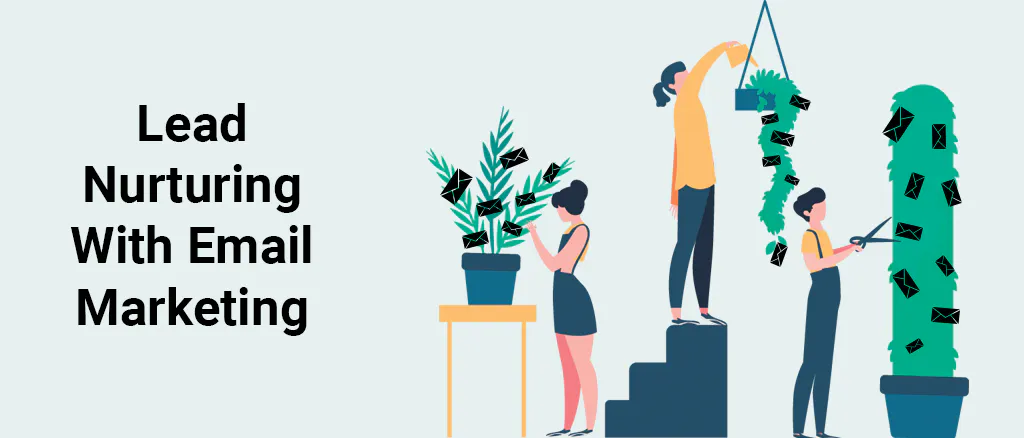How to Generate Leads in Digital Marketing
In today’s cellular devices and social media era, digital advertising has become crucial for companies to reach out to their intended audience. A well-crafted digital advertising approach can facilitate the generation of high-quality leads, which can be utilized to transform into paying clients for your enterprise.
In this article, our expert team explores how businesses can generate more leads via digital marketing. We will focus on lead generation tools and lead scoring and systems and, above all, discuss the elements that make a successful campaign!
However, what do we mean by the term “leads“? And why do they carry so much significance in bolstering your brand’s digital presence?
What are Leads in marketing?
Leads are individuals who demonstrate an interest in your enterprise’s goods or services. You can acquire leads by requesting visitors to complete a form, subscribing to a newsletter, following you on social media, or any other method that matches your enterprise’s preferences. Obtaining leads and tending to them throughout the sales funnel can enable their transformation into paying customers.
Digital marketing encompasses a variety of approaches, including search engine optimization, social media marketing, email marketing, and content creation. It is important to create a well-constructed lead generation approach to procure the appropriate type of leads.
So, how can enterprises generate leads via digital marketing? Various efficient and effective lead generation strategies exist, such as crafting invaluable content and employing lead magnets.
Additionally, optimizing landing pages, employing social media advertising, and tailoring your lead generation approach to cater to the needs and predilections of your intended audience can aid in procuring high quality leads, for your enterprise.
Digital marketing agencies can assist enterprises in finding new clients by designing and executing online campaigns. These companies possess the knowledge and resources necessary to create and execute successful lead generation plans, partnering with sales and marketing teams to synchronize their efforts and ensure that the leads generated by digital marketing agencies are superior quality and more likely to convert into paying customers.
Identifying Your Target Audience
Identifying your target users is an indispensable aspect of the lead generation process, particularly in the realm of your digital marketing campaigns. It is imperative to ascertain the identity of your targeted audience to create bespoke digital marketing campaigns that will produce high-caliber leads.
1. Significance of Identifying Your Target Audience
Discerning your target audience is paramount because it allows you to concentrate your lead generation strategies on qualified leads who will most likely transform into paying clients. By grasping your intended audience, you can develop personalized content that resonates with them and establish a rapport.
2. How to Conduct Thorough Market Research to Discover Your Target Audience
Conducting market research is a crucial element in identifying your target audience. Research your industry and competitors, and determine what distinguishes your product or service from others.
Next, collect data on your potential clients, such as their demographics, interests, pain points, and challenges. You can collect this data using surveys, social media, and customer feedback.
3. How to Create a Fictional Buyer Persona to Gain a Deeper Understanding of Your Audience
A buyer persona is an imaginary representation of your ideal client. Constructing customer personas aids in comprehending your intended audience better and customizing your sales and marketing team endeavors to fulfill their specific needs.
Consider demographics, job titles, interests, objectives, and challenges when constructing customer personas. Utilize this information to generate tailored content that resonates with your audience.
How to Create a Lead Magnet
Effective lead generation strategies are essential to generate high-quality leads for a business. Digital marketing is an excellent tool for lead generation, and using various digital marketing strategies can help capture business leads.
1. Website Optimization
One way to start generating leads is to optimize your website for search engine results pages, which can help potential customers find your business. Landing pages and lead gen forms can make search engine results pages and also capture leads from website visitors. Creating valuable content through content marketing can also attract potential leads and drive traffic to your website.
2. Social Media Marketing campaigns
Social media platforms are also powerful tools for lead generation in digital marketing. Creating a social media page and advertising campaigns can capture leads and improve lead- generation in digital marketing. Influencer marketing can also be an effective way to reach potential customers.
3. Email Marketing

Email marketing and email campaigns are another way to capture new leads and qualify them as marketing or sales-qualified leads. Our cold email marketing automation can help in this process, making capturing, qualifying, and nurturing leads easier. With Nureply, you can create email campaigns and schedule follow-ups months in advance. Use Nureply’s human-powered AI to test and iterate on your campaign’s performance continually.
4. Work with a Digital Marketing Agency
Another way to generate leads in digital marketing is to work with digital marketing agencies specializing in lead generation. These agencies can help create successful lead generation campaigns and capture a high-quality lead that is more likely to become a paying customer.
It’s important to note that not all leads are qualified prospects or sales-qualified leads. However, with the right lead generation tools and strategies, you can capture more leads and improve the quality of those leads. Working with a sales and marketing or sales team together, including customer service representatives, can also help in this process.
Optimizing Your Landing Pages
Landing pages are a necessary component of the lead generation process and making actual sales. They represent the first point of contact for visitors who arrive after clicking on an advertisement, search engine results page, or social media platform link.
A well-optimized landing page has the potential to produce more leads, and increase the number of paying customers. Here are a few pointers to help you construct an effective landing page:
1. Headline
Your landing page’s headline is the initial item that greets your visitors. It should be lucid, succinct, and compelling. Use relevant keywords for your digital marketing lead generation strategies and keep the headline length between 10 and 20 words.
2. Content
Your landing page’s content should be persuasive, succinct, and pertinent to your visitors. Use bulleted lists, short paragraphs, and uncomplicated language to captivate the attention of your site visitors. Ensure that you emphasize the benefits of your product or service and how it can address the concerns of your prospective customers.
3. Call-to-Action (CTA)
Your landing page must have a distinct and prominent CTA. It should be placed above the fold and visible without scrolling. Use action words that motivate your visitors to take action, such as “download,” “register,” or “subscribe.”
4. Elements to include in your landing page
Other elements besides the headline, content, and CTA are vital to your landing page. These include:
Images or videos that depict your product or service in action
Social proof, such as customer testimonials or reviews Trust badges, such as security certifications or awards
A form to collect your website visitors’ information
Implementing Forms on Your Website as Part of Your Lead Generation Strategies
Lead generation in digital marketing is the vital essence of any business, and integrating forms into your website is an exceptional strategy for procuring a sales-qualified sales qualified lead amount. Forms are a crucial instrument to capture potential customer data, such as their full name, email, and contact number, which can be used to maintain contact with leads and ultimately turn them into customers.
1. Practices for Optimal Form Creation in Lead Generation Marketing
In order to generate leads effectively, there are several best practices to consider when creating forms. Firstly, keeping the form brief and straightforward is essential by requesting only necessary information. Secondly, it is crucial to use clear and concise language in your form and ensure it is easy to comprehend.
Thirdly, a clear call-to-action (CTA) should be included in the form so your sales team can communicate to the visitors what they will gain after filling it out. Finally, the form should be optimized for mobile devices to ensure accessibility to all users.
2. Creating Content that Converts
Content occupies a pivotal position in the realm of digital marketing’s lead generation. It functions as an initial touchpoint for clients and corporations alike. Thus, it becomes indispensable to have an efficacious content marketing blueprint for enticing, engaging, and converting a potential customer into a marketing-qualified lead.
This segment aims to delve into the significance of content in lead generation, how to create content that results in conversions, and the types of content that have yielded the best outcomes for lead generation in marketing campaigns.
3. Significance of Content in Lead Generation
Content is the bedrock of digital marketing’s successful lead generation campaigns. It acts as the key that unlocks the door to potential clients. By dispensing valuable insights, it can secure the attention of potential clients and aid in developing an association with them. Additionally, content bolsters a brand’s authority, reinforces trust, and proposes resolutions to customers’ predicaments.
4. How to Create Content that Converts
Creating content that generates conversions is contingent upon comprehending your target audience’s necessities and tribulations. The content should be informative, captivating, and persuasive enough to guide the prospect toward the sales funnel.
The crux of the matter is providing value to the clients, whether through didactic or entertaining content. A few recommendations for crafting content that elicits conversions include:
- Familiarize yourself with your audience and grasp their needs and pain points
- Focus on providing value
- Employ persuasive language that impels action
- Enhance your content for search engines
- Employ visual aids to heighten engagement
- Ensure your content is facile to peruse and navigate
- Employ a distinct call-to-action (CTA) to steer the reader toward the subsequent stage in the sales funnel
5. Types of Content that Yield Optimal Results for Lead Generation
Multiple types of content have been observed to deliver the most desirable outcomes for lead generation. These include blog posts, videos, webinars, e-books, white papers, case studies, and infographics.
Each content category is designed to cater to a distinct purpose, offering unique advantages. Blog posts are exceptional for Search Engine Optimization (SEO) and provide a consistent flow of fresh content, whereas videos are excellent for captivating audiences and conveying intricate information in a facile format.
Webinars serve as an excellent tool in content marketing for cultivating trust and consolidating authority. E-books and white papers are ideal for dispensing comprehensive insights on a particular subject matter.
Finally, case studies and infographics are efficacious in demonstrating a product or service’s benefits.
Using Email Marketing to Nurture Leads
Email marketing is an indispensable component of any digital marketing lead generation strategy. Its utility lies in establishing and sustaining connections with potential customers, fostering trust, and boosting brand loyalty.
Provided that it is executed with care and precision, this strategy can tremendously impact the success of your sales call lead generation endeavors.

In this section, we will expound upon the significance of emails in lead generation, provide insights for creating impactful campaigns, and enumerate best practices for email marketing.
1. Significance of Email Marketing in Lead Generation
Email marketing is a cost-effective method for reaching and converting leads into buying customers. It allows for developing targeted campaigns that deliver personalized messages to leads. Furthermore, email marketing facilitates the cultivation of subscriber relationships and steers them toward making a purchase.
2. Insights for Creating Effective Emailing Campaigns
To create campaigns that pack a punch, one must gain an understanding of their audience’s needs and preferences. Here are some insights for constructing emailing campaigns that resonate with your target audience:
- Employ lead magnets to attract subscribers and provide value.
- Use striking subject lines to boost open rates. Craft email content that is both succinct and relevant.
- Incorporate a clear call-to-action (CTA) that spurs click-through rates.
- Personalize your emails to establish a connection with your subscribers.
- Experiment with various elements of your campaigns, such as sending frequency and email format, to optimize your results.
3. Best Practices for Email Marketing
The following are some best practices for email marketing that will maximize your lead generation efforts:
- Segment your email list to construct targeted campaigns for distinct subscriber groups.
- Adhere to email marketing regulations, such as providing an unsubscribe option and following anti-spam laws.
- Utilize a professional email template that embodies your brand’s image.
- Track your email campaign’s performance to assess the effectiveness of your campaigns.
- Integrate your campaigns with other marketing channels, such as social media platforms and other search engines.
- Train your sales team and a customer service representative to manage leads generated through email campaigns and promptly follow up with them.
Using Social Media to Generate Leads
Social media has emerged as a pivotal instrument for businesses to engender leads in the sphere of their digital marketing strategy. With the vast multitude of users across manifold platforms, social media provides a colossal potential audience for businesses to amplify their customer base.
In this segment, we shall broach the significance of social media in lead generation, how to harness social media to engender leads, and the best practices for social media lead generation.
1. The Significance of Social Media in Lead Generation
Social media provides a commendable platform for businesses to engage with potential patrons and create brand awareness. Businesses can establish trust and credibility with a buying customer by posting valuable content and interacting with adherents.
Social media also provides an occasion for businesses to flaunt their products or services and accentuate their distinctive selling points. This can be particularly efficacious in luring product-qualified leads who have already exhibited an interest in the business’s offerings.
2. How to Harness Social Media to Get Leads
One efficacious technique to leverage social media to generate leads is by running targeted advertising campaigns. Social media platforms offer sophisticated targeting options, enabling businesses to reach users based on demographics, interests, and behavior.
By employing a bidding strategy that optimizes the value of each click, businesses can guarantee that their advertisements are viewed by users who are most likely to become paying customers.
Another approach to exploit social media to generate leads is by crafting and distributing engaging content. By providing edifying and captivating content that resonates with their audience, businesses can attract and retain followers who are fascinated by their offerings. This can result in getting a product-qualified lead and more sales in the long run.
3. Best Practices for Social Media Lead Generation
Adherence to some best practices is imperative to derive maximal benefits from social media and lead generation tools. Primarily, businesses should ensure that their social media profiles are comprehensive and up-to-date.
This encompasses appending a profile picture, cover photo, and comprehensive information about the business.
Secondarily, businesses should frequently interact with their followers by promptly responding to comments and messages and through a sales call. This helps to establish trust and construct a devoted customer base.
Ultimately, businesses should utilize social media analytics to gauge the effectiveness of their lead generation efforts. Businesses can refine their social media strategy and generate more leads by tracking metrics such as engagement and click-through rates.
Tracking and Analyzing Your Lead Generation Efforts
Generating leads is a crucial aspect of achieving success for any business. However, the process of lead generation is not as simple as it appears at first glance. It entails considerable arduous labor, unwavering dedication, and, most importantly, unrelenting perseverance.
It is of utmost importance to closely monitor and scrutinize the lead generation endeavors to ensure the efficacy of the strategies employed.
In this subsection, we shall delve into the significance of meticulously tracking and analyzing lead generation initiatives, the tools available for the purpose, and the pivotal metrics to be tracked.
1. Significance of Tracking and Analyzing Lead Generation Endeavors
Meticulously tracking and analyzing lead generation initiatives assist businesses in discerning what works and what does not. It empowers them to identify the areas that necessitate improvement and optimize their lead generation strategies accordingly.
By analyzing the data, businesses can glean insights into the proclivities of their target audience and modify their marketing endeavors to better reach out to potential customers.
2. Tools for Tracking and Analyzing Lead Generation Endeavors
Several tools are available to track and analyze lead generation in digital endeavors. Google Analytics is among the most popular tools that furnish valuable insights into website traffic, bounce rate, and conversion rates.
Other tools, such as HubSpot, Marketo, and Pardot, can aid businesses in tracking the effectiveness of their email campaigns and social media marketing endeavors.
3. Pivotal Metrics to Track
Several pivotal metrics should be tracked when analyzing digital marketing lead generation endeavors. These encompass:
Conversion Rate – The percentage of visitors who undertake a desired action, such as filling out a form or making a purchase.
Cost per Lead – The amount of money expended to generate a lead.
Return on Investment (ROI) – The amount of revenue generated compared to the cost of the lead generation endeavors.
Lead Quality – The caliber of leads generated, such as their propensity to convert into paying customers.
Conclusion
Lead generation in digital marketing is imperative, representing a key factor for capturing business leads. To obtain high-caliber leads, you must devise a meticulously crafted lead-generation strategy tailored to both new and existing customers.
In order to achieve this, it is essential to work with digital marketing agencies to identify the target audience. Effective lead generation methodologies center around the creation of content and the utilization of lead magnets.
Optimizing landing pages, leveraging social media channels, and customizing the digital marketing lead generation approach to suit the needs of the audience also contribute to a successful digital marketing strategy in lead generation.


